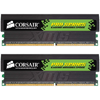- Qualcomm Launches Snapdragon 4 Gen 2 Mobile Platform
- AMD Launches Ryzen PRO 7000 Series Mobile & Desktop Platform
- Intel Launches Sleek Single-Slot Arc Pro A60 Workstation Graphics Card
- NVIDIA Announces Latest Ada Lovelace Additions: GeForce RTX 4060 Ti & RTX 4060
- Maxon Redshift With AMD Radeon GPU Rendering Support Now Available
Corsair 2GB TWINX2048-4400PRO

Corsair once again wants the top spot in the DDR market, and they have it. The 4400PRO is the only 2GB kit available at these speeds, which is reason enough to check them out. Well, they prove very fast as we had hoped, despite the somewhat loose timings. Let’s take a deeper look.
Page 3 – Overclock Ability & Testing Procedures
Because these modules are top of their class, it’s hard to expect much overclock ability out of them. What’s nice though, is that all the settings performed were all done using only 2.8 VDIMM. Increasing the VDIMM did not have much of an affect on the overclock.
Sadly, I have not completed any full tests using the modules above stock speeds. I have previously gotten the modules to 285MHz, and that proved 2D stable but not 3D stable. I will continue to tweak the modules after this review, and if anything else if found, I will add it to the review.
At the time these overclocks were performed, 275MHz with either 1T or 2T proved non 3D Stable. However, Corsair sent me a hand-picked kit that had proved 3D Stable at stock speeds in their Ultra-D on-hand. After testing with those modules, they proved completely 3D Stable at stock speeds. I played Half-Life 2 for an hour and looped 3D Mark 01 and 3D Mark 06 for a few hours. With my other kit, ’01 would crash within a minute. As mentioned earlier, it’s really hit or miss whether or not you will get a kit completely suited for your motherboards liking.
In any case, here is the list of the overclocks I played with. These modules are dual-speced for DDR-400 speeds also. So, you could buy the modules and use DDR400 speeds in case you have that need. Of course, that may sound ridiculous. I have known many people who have bought memory before they had a new motherboard and CPU though, so it’s a nice feature to have.
- Stable Overclocks
- 275MHz, 3-4-4-8 1T
- 275MHz, 3-4-4-8 2T
- 275MHz, 3-3-2-0 2T
- 272MHz, 3-3-2-0 1T
- 250MHz, 3-4-4-8 1T
- 227MHz, 2-3-2-5 1T
- 200MHz, 3-3-3-8 1T
You may notice that the tRAS is at 0, and no that is not a typo. I have been running my PC at 2.65GHz with 265MHz memory and 3-3-2-0 timings for over two weeks now and have not had a single stability issue. tRAS doesn’t usually make a large difference, but it’s nice to see a 0 in your timings once in a while. If only the tRP and tRCD were as friendly ;)
One last thing to mention is the fact that these modules are rated for 2T, not 1T. This may seem odd, because 2T is usually only used for a 4 module configuration. Due to the high speeds of these modules though, Corsair deemed them to be more suitable for 2T.
On this page, I will explain how our testing procedures go. Firstly, the hard drive that hosts the operating system is fully defragged using Diskeeper 10 to assure no hiccups will be due to the OS. All testing occurs on a standalone OS installation that’s dedicated to testing. Second, all unnecessary programs in Windows are closed down, minus the essential ones. This includes virus scanners, firewalls, peripheral software, etcetera. Before any testing occurs, the memory goes through a 4 hour MemTest run at stock settings to assure that they are error free and appropriate for overclocking and benching.
To test out the modules, I used the usual variety of benchmarking tools. No games are included in our memory benchmarking, because I consider them to be a waste of time. Overclocking your memory generally means overclocking your CPU in conjunction, which makes it hard to diagnose just what kind of difference the memory made. Here is the selection of tools we use in the review:
- Test System
- CPU: AMD Venice 3200+ @ 2.75GHz
- Motherboard: DFI Ultra-D w/ 406BTA BIOS
- Memory: Corsair 2GB 4400PRO
- Video: eVGA 7800GT
- Sound: Chaintech AV-710
- Storage: WD 200GB 7200 8MB
- Odds and Ends: D-Link WiFi PCI Card
- Etcetera: Windows XP Professional SP2, Windows x64 Professional SP1, NVIDIA 81.98 Drivers
Throughout all of our graphs, you will see this structure: “200MHz 4-4-3-8 1T”. The first number is obviously the frequency, followed by the timings. 1T or 2T refers to the command rate. The timings are listed as CAS-tRCD-tRP-tRAS.
|
|
Support our efforts! With ad revenue at an all-time low for written websites, we're relying more than ever on reader support to help us continue putting so much effort into this type of content. You can support us by becoming a Patron, or by using our Amazon shopping affiliate links listed through our articles. Thanks for your support!





